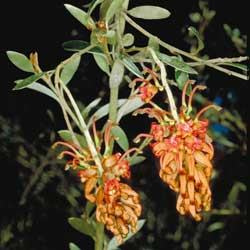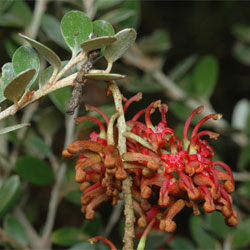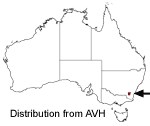Grevillea diminuta
 |
 |
Grevillea diminuta L.A.S.Johnson
Grevillea
diminuta belongs to the Proteaceae family. It has no common name, although
it is widely cultivated throughout the A.C.T. region and surrounds. G. diminuta lives in a restricted geographical distribution, being found in the Brindabella
Ranges, Bimberi National Park and Namadgi National Park..  Two
other populations have also been found near Tidbinbilla Peak, and north of the
Honeysuckle Creek Tracking Station, both in the Australian Capital Territory. G. diminuta lives in a range of less than 100km2, and is considered
Rare and Conserved by the Commonwealth Government. Being an alpine species, G. diminuta is adapted to live in harsh environments and is often found
on rocky slopes with Podocarpus lawrencei and in Sclerophyll Woodland
with Eucalyptus pauciflora (snow gum), between 1400 and 1800m above sea
level.
Two
other populations have also been found near Tidbinbilla Peak, and north of the
Honeysuckle Creek Tracking Station, both in the Australian Capital Territory. G. diminuta lives in a range of less than 100km2, and is considered
Rare and Conserved by the Commonwealth Government. Being an alpine species, G. diminuta is adapted to live in harsh environments and is often found
on rocky slopes with Podocarpus lawrencei and in Sclerophyll Woodland
with Eucalyptus pauciflora (snow gum), between 1400 and 1800m above sea
level.
This beautiful, spreading shrub grows to 1m in height, and up to 4m in diameter. The young stems are covered in fine rusty-red hairs. The thick leaves are 1-2cm long, elliptical to ovate, with the upper surfaces covered in flattened white hairs when young and becoming hairless with age, revealing a glossy, rich green colour. The lower surfaces of the leaves are covered with flattened silky hairs that persist with age, exposing a silvery, white colour. The striking flowers hang in pendulous clusters from the cascading branches, the outer being a rusty-red, and inner a bright pink-red. G. diminuta flowers from usually September to December. The fruit appear after flowering, and consist of circular woody capsules to 1.5cm in diameter that release two seeds at maturity.
Natural populations regenerate from seed, although nursery propagated plants are usually grown from cuttings from many different plants, and show great variation in form and colour. To grow your own G. diminuta plants from cuttings, it is best to take your cuttings from the hardened new growth that arises between October and April. The plant producing your cutting material should have finished a growth surge, with a clean and healthy appearance and no moulds on the stems. Cut it into 7-10cm lengths, and trim the leaves off the lower half of the cutting, ensuring no bark is torn off the stem. Remove young growing shoots or flowers. Dip the cut end into a rooting hormone powder to stimulate faster, more reliable root growth. Grevilleas prefer a low nutrient propagation mix, like 1:2 parts peat moss and coarse sand. Place the entire pot in a plastic bag and seal. The new cutting will produce roots in about 4 to 8 weeks, and can be potted up once the roots are 3-5cm long.
This species is frost tolerant, can grow in full sun or part shade and attracts many native Australian birds. To promote bushiness, branches should be cut back after flowering. G. diminuta will grow best in dry or moist well-drained soils, and should only be fertilised with a low-phosphorus native plant food. G. diminuta grown from cuttings have lower, denser growth; early flowering; and shallower, fibrous root systems. Once established, this beautiful species requires little attention and will flower every year. G. diminuta is a striking addition to any home garden or rockery .
Text by Katherine Nelson (2003 Student Botanical Intern)
Name meaning: Grevillea diminutaGrevillea- after C. F. Greville, a patron of botany, and once vice-president of the Royal Society of London; diminuta - means 'diminutive', and refers to the small size of each flower. |
References
Briggs, J.D. & Leigh, J.H. (1985) Delineation of Important Habitats of Rare and Threatened Plant Species in the Australian Capital Territory. CSIRO Plant Industry: Canberra.
Briggs, J.D. & Leigh, J.H. (1996) Rare or Threatened Australian Plants. CSIRO Australia: Collingwood, Victoria.
Burke, D. (1983) Growing Grevilleas. Kangaroo Press: Kenthurst, N.S.W.
Commonwealth of Australia (2000) Flora of Australia- Volume 17A, Proteaceae 2, Grevillea. Australian Biological Resources Study/CSIRO Australia: Melbourne.
Olde, P & Marriot, N. (1994) The Grevillea Book- Volume One. Kangaroo Press: Kenthurst, N.S.W.
Wrigley, J.W. (1989) Banksias, Waratahs and Grevilleas- and all other plants in the Australian Proteaceae family. Collins Publishers Australia: Sydney.
![An Australian Government Initiative [logo]](/images/austgovt_brown_90px.gif)

